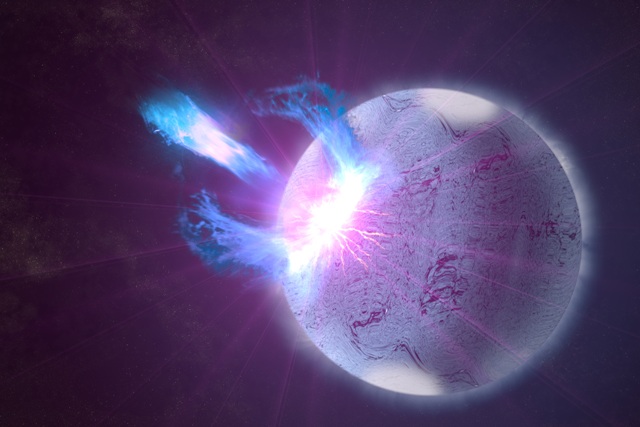Magnetar 'Storm' provides hints of Starquakes
 Washington, Oct 22 : A rapid-fire "storm" of high energy explosion from extremely magnetized neutron star, also called as a magnetar, detected by NASA's Fermi Gamma-ray Space Telescope on Jan. 22, 2009 has now provided hints of Starquakes to the astronomers.
Washington, Oct 22 : A rapid-fire "storm" of high energy explosion from extremely magnetized neutron star, also called as a magnetar, detected by NASA's Fermi Gamma-ray Space Telescope on Jan. 22, 2009 has now provided hints of Starquakes to the astronomers.
Astronomers analyzed the data and have discovered underlying signals related to seismic waves rippling throughout the magnetar.
Such signals were first identified during the fadeout of rare giant flares produced by magnetars. Over the past 40 years, giant flares have been observed just three times, in 1979, 1998 and 2004, and signals related to starquakes, which set the neutron stars ringing like a bell, were identified only in the two most recent events.
While typical neutron stars possess magnetic fields trillions of times stronger than Earth's, the eruptive activity observed from magnetars requires fields 1,000 times stronger still. To date, astronomers have confirmed only 23 magnetars.
Because a neutron star's solid crust is locked to its intense magnetic field, a disruption of one immediately affects the other. A fracture in the crust would lead to a reshuffling of the magnetic field, or a sudden reorganization of the magnetic field may instead crack the surface.
Either way, the changes trigger a sudden release of stored energy via powerful bursts that vibrate the crust, a motion that becomes imprinted on the burst's gamma-ray and X-ray signals.
Anna Watts, an astrophysicist at the University of Amsterdam in the Netherlands, said that according to them these are likely twisting oscillations of the star where the crust and the core, bound by the super-strong magnetic field, are vibrating together and they also found in a single burst, an oscillation at a frequency never seen before. (ANI)